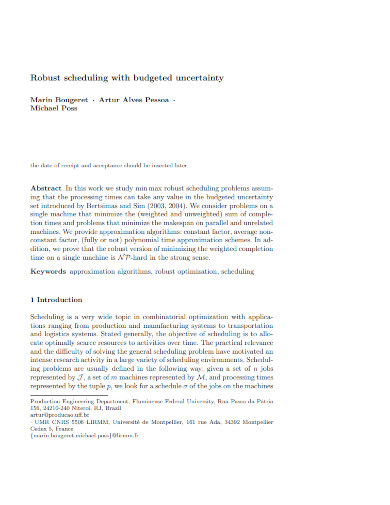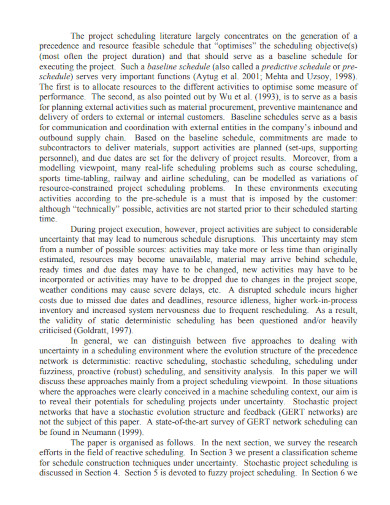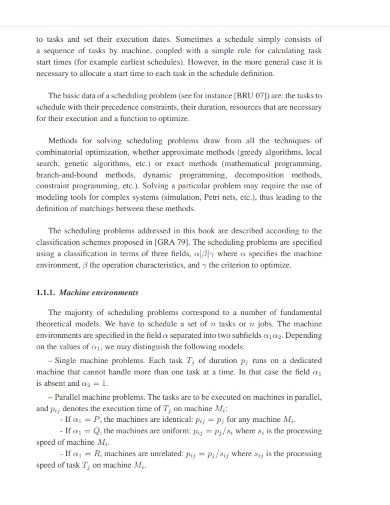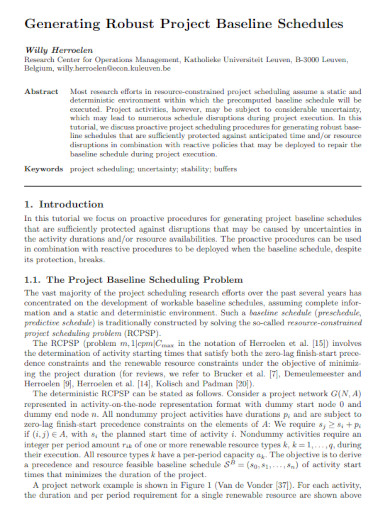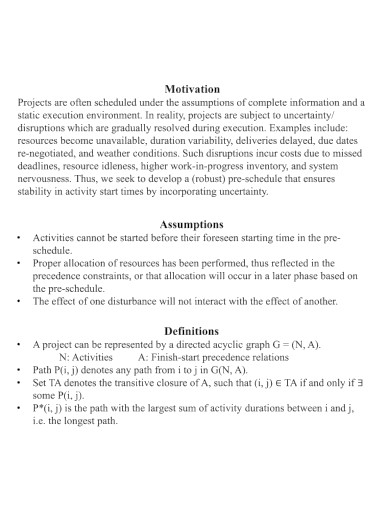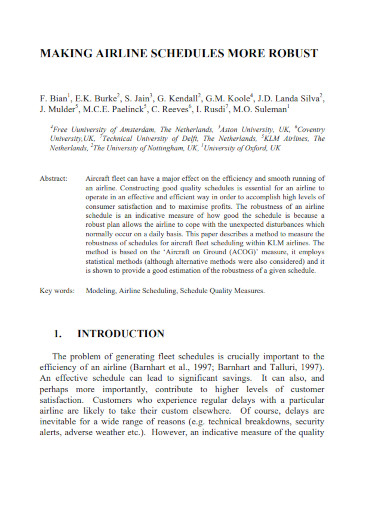5+ Robust Schedule Samples
Producing high-quality schedules is critical for an airline to operate in an effective and efficient manner in order to satisfy customers and maximize profits. Typically, airlines design their flight schedules on the assumption that every aircraft leg would depart and arrive on time. However, due to delays and cancellations, timetables are frequently more volatile than anticipated during preparation. You need to ensure that systems are in place for your robust schedule, do you want some assistance? Don’t worry, we’ve got you covered! In this article, we provide you with free and ready-made samples of Robust Schedules in PDF and DOC format that you could use for your benefit. Keep on reading to find out more!
1. Robust Scheduling Budgeted Uncertainty
2. Robustness in Project Scheduling
3. Flexibility and Robustness in Scheduling
4. Generating Robust Project Baseline Schedules
5. Robust Project Scheduling
6. Making Airline Robust Schedule
What is a robust schedule?
A robust flight schedule indicates how excellent the schedule is since it helps the airline to deal with the unforeseen disruptions that occur on a daily basis with a particular regularity. A solid schedule is an airline’s be-all and end-all: it determines its product, revenue potential, and operational expenses. Airlines shift the majority of the unpredictability in travel times to their consumers by arranging their flights closer to the shortest possible journey time.
How to make a robust schedule
Though it appears to be a straightforward and easy task, establishing this operating timetable does need some work. It goes through several iterations during the project since modifications are unavoidable. A Robust Schedule Template can help provide you with the framework you need to ensure that you have a well-prepared and robust schedule on hand. To do so, you can choose one of our excellent templates listed above. If you want to write it yourself, follow these steps below to guide you:
#1. Select the Correct Tools.
Whether your project is modest or large, you will need the necessary tools to make it a success. Your project will be chaos without them. So, look for software with capabilities like multiple project views, scheduling, automation, team communication, time tracking, guest access, straightforward admin operations, and an intuitive user interface. These tools will help you simplify your project, stay on time, and maintain total control from start to finish.
#2. Recognize the Work Plan.
You will have a clear image of how to schedule your project after you comprehend these factors. It is strongly advised that you consult with important project stakeholders to fully grasp your breakdown structure, timetables, and project deliverables.
#3. Establish Your Goals.
Accomplishments denote the conclusion of a significant phase of work. Similarly, each project has its own set of milestones that steer the project or a project stage to completion. You should avoid designating every other task as a milestone during this procedure. Remember that milestones represent significant accomplishments that may be celebrated. If we celebrate every other task, we will fail to meet the project’s final goals.
#4. Stakeholders should be consulted.
You should now have all of the information you need to establish your project schedule. The next step is to publish the schedule on your project management software and share it with your stakeholders for additional discussion. To guarantee that your milestones are well-defined and ordered, you can utilize scheduling strategies such as a critical route or critical chain.
#5. Be prepared to adapt to changes.
Every project experiences scope creep. Though planning and scheduling are vital and should be done, ad hoc requests or even substantial modification requests from customers and stakeholders will occur during the project. When this occurs, you must be prepared to evaluate your schedule and make any required modifications. Of course, these changes might be significant at times and minor at others. As you can see, one of the most successful methods to manage change is through consistent communication. Use communication technologies such as internal chats, video conferencing, and on-task communication to ensure a seamless process and speedier outcomes.
FAQ
Why is airline scheduling important?
Even though an airline’s schedule cannot change the unpredictability of a flight’s journey time, it may make passengers more likely to arrive on time or early.
What is the significance of flight planning?
The scheduling plan optimizes the amount of traffic available and the amount of capacity provided. Excessive frequency might be costly for an airline.
How are airline schedules created?
The airline schedule planning process is a fairly complicated procedure that includes several stages and a significant number of airline resources. Typically, the procedure is divided into four subproblems: schedule design, fleet assignment, aircraft routing, and crew scheduling.
The scheduling plan optimizes the amount of traffic available and the amount of capacity provided. If the schedule is incorrect and the airline flies too many flights on a certain route, some of the planes may depart with vacant seats. To help you get started, download our easily customizable and comprehensive samples of Robust Schedules today!
Related Posts
FREE 10+ Employees Schedule Samples in PDF
FREE 10+ On Call Schedule Samples in PDF
FREE 10+ Time Block Schedule Samples in PDF
FREE 10+ Gym Schedule Samples in PDF | MS Word | Apple Pages | Google Docs | Keynote |
FREE 10+ Daily Hourly Schedule Samples in PDF
FREE 10+ Weekly Schedule Template with Hours Samples in PDF
FREE 10+ 7 Day Weekly Schedule Samples in PDF
FREE 10+ Working Schedule Template Samples in PDF
FREE 6+ Preschool Schedule Template Samples in PDF
FREE 10+ Daily School Schedule Samples in PDF | MS Word | Google Docs | Google Sheets | Excel
FREE 10+ Day Schedule Samples in PDF
FREE 10+ Daily Work Schedule Samples in PDF
FREE 10+ 24 Hours Schedule Samples in PDF | Word | Google Docs | Google Sheets | Excel | Apple Numbers | Apple Pages
FREE 10+ Baseball Schedule Samples in PDF
FREE 10+ Availability Schedule Samples in PDF

